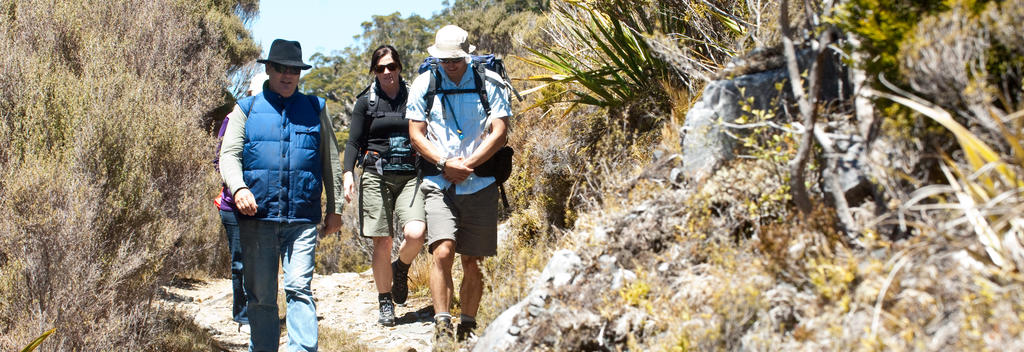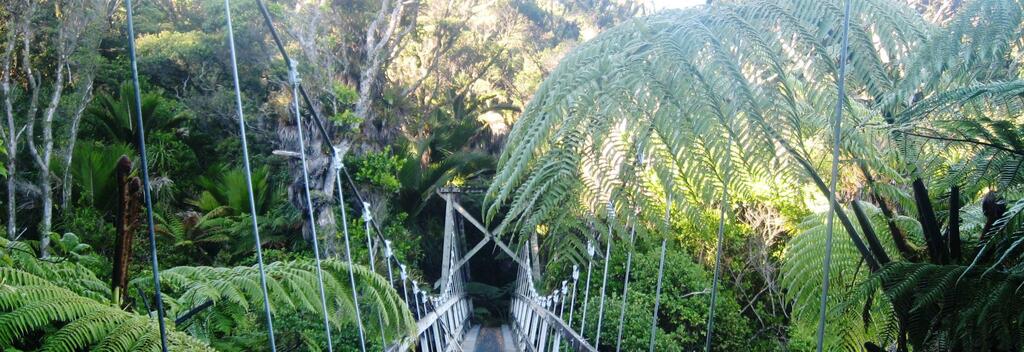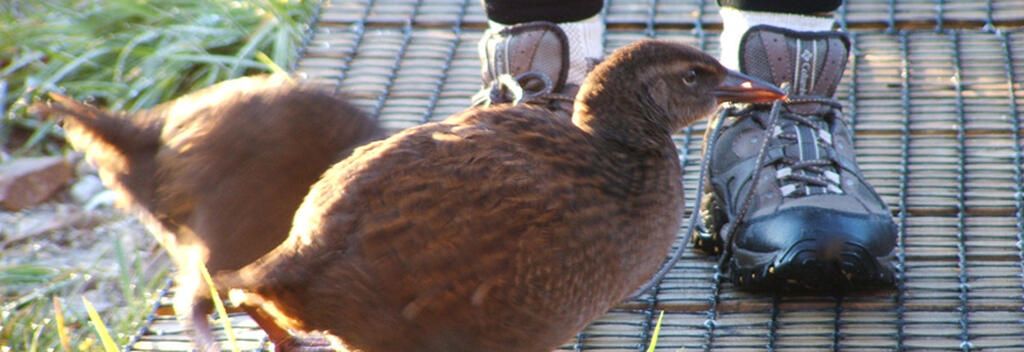-
Popular places to visit
Popular things to do
Helpful tips
Here's a few useful links to help with planning your trip to Aotearoa New Zealand.
-
For the latest information on access to the Heaphy Track please refer to the Department of Conservation's Heaphy Track page(opens in new window).
This ancient Māori trail crosses over tussock downs to lush forests, through nikau palms, to the roaring seas of the West Coast.


Of all the Great Walks, the Heaphy Track delivers the strongest contrasts and every section of the track is vastly different.
The trail showcases superb rainforest, sub-alpine tussock grasslands, high, rugged mountains and lowland forest and palm-fringed surf beaches.
Heaphy Track is 82 kilometres within the Kahurangi National Park, the second largest national park in the country and home to many Great Spotted kiwi, interesting rock formations, caves and natural arches.
The path followed by the Heaphy Track was first used by Māori pounamu (jade) hunters travelling from Golden Bay to the pounamu rivers of Westland.
Mountain bikes are allowed between 1st May and 30th November.


The fitter you are the more you will enjoy yourself, so a good level of fitness and strength is necessary.
Find out more about the walk and what is involved;
Day 1, Brown Hut > Perry Saddle, 17.5km
Starting at Brown Hut(opens in new window), you'll head upstream before crossing the bridge over the Brown River.
From here the track gradually climbs to a saddle with beautiful views across the Aorere Valley - on a clear day it is even possible to see the conical peak of Taranaki Maunga, on of the North Island's highest mountains. This is the highest point on the track. The track then dips slightly, leading to Perry Saddle Hut(opens in new window). A deep pool nearby offers a refreshing swim - not for the faint-hearted, but all feelings of fatigue will vanish the moment you hit the cold water.
Day 2, Perry Saddle > Saxon Hut, 12.4km
Today, journey through tussock to Gouland Downs before coming to the quirky 'boot pole' - which wears a variety of old boots, bestowed by hikers over many years.
There is a limestone outcrop where you can explore caves and waterfalls - take a torch and see if you can find a cave spider. You'll then hike through flat tussock country to reach Saxon Hut(opens in new window), nestled at the end of the downs.
Day 3, Saxon Hut > James Mackay Hut, 11.8km
Today's journey winds through more tussock and bush flats, criss-crossed by rivers and various bridges.
Small creeks dissect the landscape and pink granite sparkles and crunches beneath your boots. The James Mackay Hut(opens in new window) sits on an open terrace just above the track. In the distance, both the Tasman Sea and the Heaphy River can be seen from here.
Day 4, James Mackay Hut > Heaphy Hut, 20km
First off today you'll gradually descend towards the Heaphy River, surrounded by a rainforest of kōwhai, cabbage trees and nikau palms.
A detour to see one of New Zealand’s biggest rātā trees is definitely worthwhile. Further up the river you'll come to a huge 148-metre suspension bridge, crossing the water and the river flats. As you follow the track towards the mouth of the river, nikau palms become more common, the sea’s roaring grows louder and in some conditions, small waves can be seen running upriver.
Heaphy Hut(opens in new window) is situated far enough back from the sea to be spared the worst of the winds.
Day 5, Heaphy Hut > Kohaihai Carpark, 16.2km
At the mouth of the Heaphy River water surges out through a narrow gap into the sea. In-coming waves halt the flow and the resulting churning of salt water and fresh water is spectacular.
The majority of today's hike is through forest although there is some beach walking.
You'll soon reach the Scotts Beach clearing which is a great spot to rest before climbing the Kohaihai Saddle and meandering down to the bridge to cross the river. Shortly after crossing the bridge you'll reach the Kohaihai Carpark where there is both shelter and a phone.
The Heaphy Track is not a loop walk so hikers having the option of walking west to east or east to west.
From the west, the town of Westport offers multiple options for accommodation.
In the east, the town of Takaka in the Nelson Tasman region is also home to many options for places to stay.

The Heaphy Track is not a circuit track so you need to organise transport.
You can start the track either from Brown Hut in Golden Bay(156 kilometres from Nelson) or from Kohaihai on the West Coast (110 km from Westport).
Regional flights allow you to walk the track one way and return by air to near your starting point. Air New Zealand flies into Nelson, the closest regional airport to the Brown Hut, and Sounds Air(opens in new window) flies into Westport, the closest regional airport to Kohaihai(opens in new window).
A number of local operators provide air transport into Takaka in Golden Bay and Karamea on the West Coast.
Bus and taxi services are available to reach either end of the track from nearby towns - some only operate during the summer months so you need to check in advance. Regular bus services link Nelson and Westport. Vehicle relocation services are also available.
There is mobile phone coverage at both ends of the Heaphy Track.


A number of specialist tour operators can aid in bringing your walking experience to life. Contact the business to find out if a walking tour is right for you.
If you want to do a Great Walk independently, you will need to book the DOC accommodation on the trails. The fee for this varies between each Great Walk. It is recommended that you book in advance for this popular walk.

Plan My Walk takes the guesswork out of your preparation by bringing together the right information needed for planning a safe and successful walk or tramp.
The Great Hikes App is a comprehensive guide to plan your New Zealand Great Walk.
Department of Consevation provides detailed information about this trail, accommodation, gear list, and safety information.
The Tiaki Promise is a commitment to care for New Zealand, for now, and for future generations.